The Intel Core i9-9900KS Review: The 5 GHz Consumer Special
by Dr. Ian Cutress on October 31, 2019 10:45 AM ESTCPU Performance: Web and Legacy Tests
While more the focus of low-end and small form factor systems, web-based benchmarks are notoriously difficult to standardize. Modern web browsers are frequently updated, with no recourse to disable those updates, and as such there is difficulty in keeping a common platform. The fast paced nature of browser development means that version numbers (and performance) can change from week to week. Despite this, web tests are often a good measure of user experience: a lot of what most office work is today revolves around web applications, particularly email and office apps, but also interfaces and development environments. Our web tests include some of the industry standard tests, as well as a few popular but older tests.
We have also included our legacy benchmarks in this section, representing a stack of older code for popular benchmarks.
All of our benchmark results can also be found in our benchmark engine, Bench.
WebXPRT 3: Modern Real-World Web Tasks, including AI
The company behind the XPRT test suites, Principled Technologies, has recently released the latest web-test, and rather than attach a year to the name have just called it ‘3’. This latest test (as we started the suite) has built upon and developed the ethos of previous tests: user interaction, office compute, graph generation, list sorting, HTML5, image manipulation, and even goes as far as some AI testing.
For our benchmark, we run the standard test which goes through the benchmark list seven times and provides a final result. We run this standard test four times, and take an average.
Users can access the WebXPRT test at http://principledtechnologies.com/benchmarkxprt/webxprt/
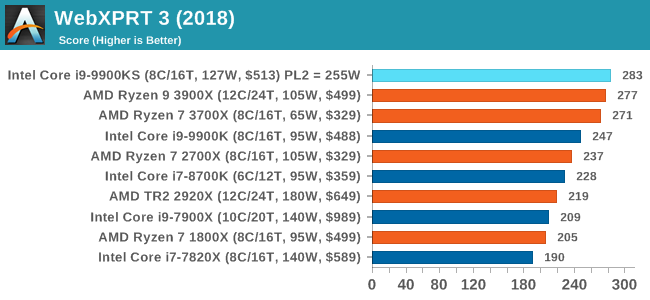
WebXPRT 2015: HTML5 and Javascript Web UX Testing
The older version of WebXPRT is the 2015 edition, which focuses on a slightly different set of web technologies and frameworks that are in use today. This is still a relevant test, especially for users interacting with not-the-latest web applications in the market, of which there are a lot. Web framework development is often very quick but with high turnover, meaning that frameworks are quickly developed, built-upon, used, and then developers move on to the next, and adjusting an application to a new framework is a difficult arduous task, especially with rapid development cycles. This leaves a lot of applications as ‘fixed-in-time’, and relevant to user experience for many years.
Similar to WebXPRT3, the main benchmark is a sectional run repeated seven times, with a final score. We repeat the whole thing four times, and average those final scores.
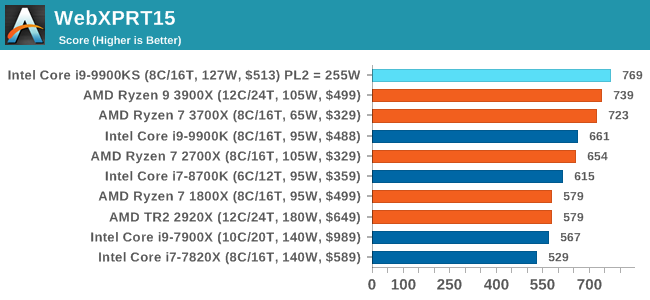
Speedometer 2: JavaScript Frameworks
Our newest web test is Speedometer 2, which is a accrued test over a series of javascript frameworks to do three simple things: built a list, enable each item in the list, and remove the list. All the frameworks implement the same visual cues, but obviously apply them from different coding angles.
Our test goes through the list of frameworks, and produces a final score indicative of ‘rpm’, one of the benchmarks internal metrics. We report this final score.
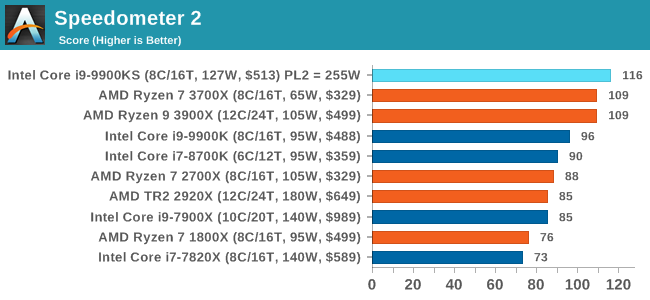
Google Octane 2.0: Core Web Compute
A popular web test for several years, but now no longer being updated, is Octane, developed by Google. Version 2.0 of the test performs the best part of two-dozen compute related tasks, such as regular expressions, cryptography, ray tracing, emulation, and Navier-Stokes physics calculations.
The test gives each sub-test a score and produces a geometric mean of the set as a final result. We run the full benchmark four times, and average the final results.
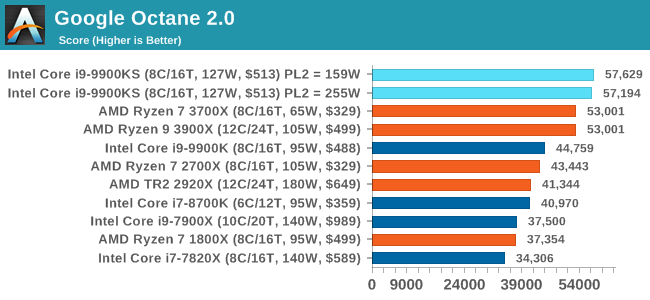
Mozilla Kraken 1.1: Core Web Compute
Even older than Octane is Kraken, this time developed by Mozilla. This is an older test that does similar computational mechanics, such as audio processing or image filtering. Kraken seems to produce a highly variable result depending on the browser version, as it is a test that is keenly optimized for.
The main benchmark runs through each of the sub-tests ten times and produces an average time to completion for each loop, given in milliseconds. We run the full benchmark four times and take an average of the time taken.
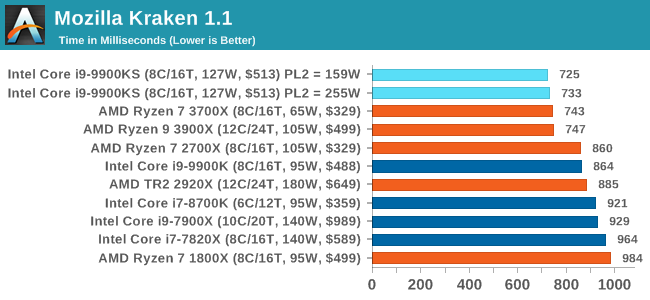
3DPM v1: Naïve Code Variant of 3DPM v2.1
The first legacy test in the suite is the first version of our 3DPM benchmark. This is the ultimate naïve version of the code, as if it was written by scientist with no knowledge of how computer hardware, compilers, or optimization works (which in fact, it was at the start). This represents a large body of scientific simulation out in the wild, where getting the answer is more important than it being fast (getting a result in 4 days is acceptable if it’s correct, rather than sending someone away for a year to learn to code and getting the result in 5 minutes).
In this version, the only real optimization was in the compiler flags (-O2, -fp:fast), compiling it in release mode, and enabling OpenMP in the main compute loops. The loops were not configured for function size, and one of the key slowdowns is false sharing in the cache. It also has long dependency chains based on the random number generation, which leads to relatively poor performance on specific compute microarchitectures.
3DPM v1 can be downloaded with our 3DPM v2 code here: 3DPMv2.1.rar (13.0 MB)
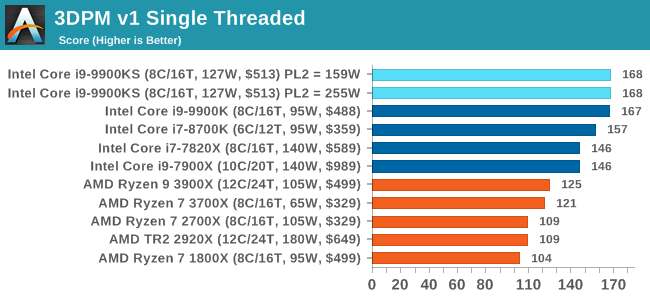
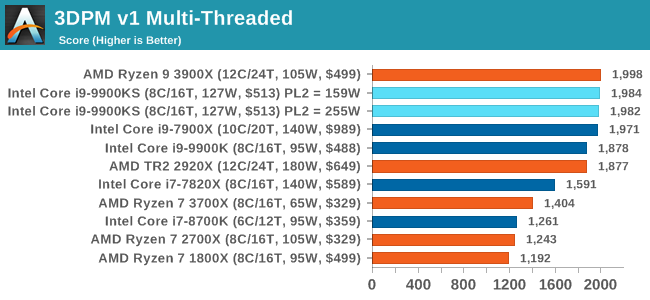
x264 HD 3.0: Older Transcode Test
This transcoding test is super old, and was used by Anand back in the day of Pentium 4 and Athlon II processors. Here a standardized 720p video is transcoded with a two-pass conversion, with the benchmark showing the frames-per-second of each pass. This benchmark is single-threaded, and between some micro-architectures we seem to actually hit an instructions-per-clock wall.
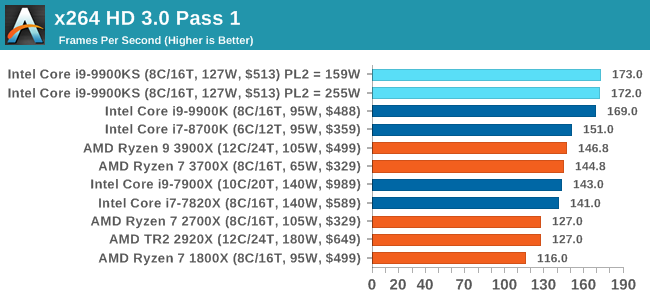











235 Comments
View All Comments
Agent Smith - Friday, November 1, 2019 - link
Only one year warranty with this CPU, reduced from 3yrs. So it’s marginally faster, uses more power, offers no gaming advantages and it’s price hike doesn’t justify the performance gain and warranty disadvantage over 9900k.... and the 3950x is about to arrive. Mmm?
willis936 - Friday, November 1, 2019 - link
Counter strike really needs to be added to benchmarks. It’s just silly how useless these gaming benchmarks are. There is virtually nothing that separates any of the processors. How can you recommend it for gaming when your data shows that a processor half the price is just as good? Test the real scenarios that people would want to use this chip.Xyler94 - Friday, November 1, 2019 - link
It's more because you need a specific set of circumstances these days to see the difference in gaming that's more than margin of error.You need at least a 2080, but preferably a 2080ti
You need absolutely nothing else running on the computer other than OS, Game and launcher
You need the resolution to be set at 1080p
You need the quality to be at medium to high.
then, you can see differences. CS:GO shows nice differences... but there's no monitor in the world that can display 400 to 500FPS, so yeah... Anandtech still uses a 1080, which is hardly taxing to any modern CPU, that's why you see no differences.
willis936 - Friday, November 1, 2019 - link
csgo is a proper use case. It isn’t intense, graphically, and people regularly play with 1440p120. Shaving milliseconds off input to display latency matters. I won’t go into an in depth analysis to why, but imagine a human response time has a gaussian distribution and whoever responds first wins. Even if the mean response time is 150 ms, if the standard deviation is 20 ms and your input to display latency is 50 ms then there are gains to cutting 20, 10, even 5 ms off of it.And yes, more fps does reduce input latency, even in cases where the monitor refresh rate is lower than the fps.
https://youtu.be/hjWSRTYV8e0
Xyler94 - Tuesday, November 5, 2019 - link
If you visually can't react fast enough, doesn't matter how quickly the game can take an input, you're still limited on the information presented to you. 240hz is the fastest you can go, and 400FPS vs 450FPS isn't gonna win you tournaments.CS:GO is not a valid test, as there's more to gaming than FPS. Input lag is more about the drivers and peripherals, and there's even lag between your monitor and GPU to consider. But go on, pretend 50FPS at 400+ makes that huge of a difference.
solnyshok - Friday, November 1, 2019 - link
No matter what GHz, buying a 14nm/PCIE3 chip/mobo just before 10nm/PCIE4 comes to the market... Seriously? Wait another 6 months.mattkiss - Friday, November 1, 2019 - link
10nm/PCIe 4 isn't coming to desktop next year, where did you hear that?eek2121 - Friday, November 1, 2019 - link
The 3700X is totally trolling Intel right now.RoboMurloc - Friday, November 1, 2019 - link
I dunno if anyone mentioned yet, but the KS has additional security measures to mitigate exploits which are probably causing the performance regressions.PeachNCream - Friday, November 1, 2019 - link
I expect I will never own an i9-9900KS or a Ryzen 7 3700X, but it is interesting to see how close AMD's 65W 8 core chip gets to Intel's 127+W special edition CPU in terms of performance in most of these benchmarks.